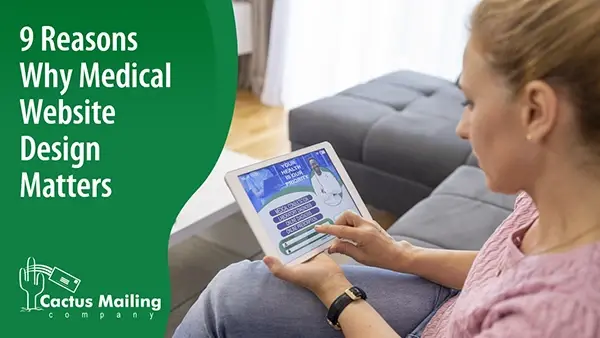We Are Here to Help!
Get pricing details and strategies that will work for your business.
The Internet has become the go-to source for information and services across all industries, and healthcare is no exception. For any healthcare organization, or medical practices and healthcare providers, a solid online presence is not just beneficial—it's essential. At the heart of this online presence is your medical website's design. This critical element can significantly impact your practice's success. In this article, we delve into the pivotal role of medical website design and explore why it matters more than ever before in the healthcare industry.
From building trust with your prospective patients, to enhancing the overall patient experience and boosting your online visibility, the design of your medical website plays a multifaceted role in shaping the future of your practice. Join us as we uncover why investing in a well-designed medical website is a prescription for success in the modern healthcare landscape.

Trust and Credibility Building
Your medical website is often the first point of contact between your practice and potential patients. A professionally designed website makes a positive first impression and builds trust and credibility.
Professional Design: A well-designed medical website conveys professionalism, which is vital for building trust with potential patients. It reassures them that your practice is reliable and competent.
Patient Confidence: When patients encounter an outdated or poorly designed website, they may question the quality of care they'll receive. In contrast, a modern and visually appealing design instills confidence and trust.
Enhancing Patient Experience
A seamless online experience is now an expectation for patients. A more mobile friendly and well-designed medical website can enhance the overall patient experience, making accessing the care they need more accessible.
- Easy Navigation: An intuitively organized website ensures that patients can effortlessly find the information they need, leading to a positive user experience.
- Mobile Compatibility: In today's mobile-centric world, ensuring that your website functions seamlessly on smartphones and tablets is essential. Mobile responsiveness guarantees a consistent and enjoyable experience for all visitors.
- User-Friendly Features: Incorporating user-friendly features, such as clear call-to-action buttons and straightforward menu structures, enhances the overall experience.
Providing Comprehensive Information
Patients are hungry for information about their healthcare options. Providing comprehensive details on your services, providers, and procedures empowers patients to make informed decisions.
- Informed Decisions: Patients seek detailed information about your services, healthcare providers, and medical procedures. Providing comprehensive content empowers them to make informed decisions about their healthcare.
- Educational Resources: Beyond basic information, offering educational resources, FAQs, and articles on healthcare topics showcases your commitment to patient education and care.
Booking for Healthcare Service
Scheduling medical appointments should be hassle-free, so implementing an efficient online booking system can increase patient engagement and streamline the appointment process.
- Convenience: A user-friendly online appointment booking system simplifies the scheduling process for patients. It significantly increases the likelihood of patients following through with appointments, leading to improved patient engagement.
- Vital Information: Essential details such as your practice's location, operating hours, and contact information should be prominently displayed for easy patient access.

Highlighting Specializations
The expertise of the healthcare providers in your medical practice sets you apart. Showcasing their qualifications and specializations on healthcare websites helps patients choose the right provider for specific needs.
- Provider Profiles: Showcasing the qualifications, certifications, and specializations of your healthcare providers helps patients select the right provider for their specific healthcare needs.
- Trust-building: Detailed provider profiles and professional backgrounds create a sense of familiarity and trust with potential patients.
Showcasing Success Stories
Seeing is believing, especially in healthcare, and showcasing success stories to new patients through photos, testimonials, and case studies can instill confidence in potential patients.
- Visual Evidence: Before-and-after photos, patient testimonials, and case studies provide visual evidence of the positive outcomes of medical treatments. These elements strongly influence patient decisions and build confidence in your practice.
Website Accessibility and Inclusivity
Your healthcare website design can cater to the diverse needs of patients, ensuring that everyone can access the care they deserve because inclusivity matters in healthcare.
- Catering to Diverse Needs: Websites should address the diverse requirements of patients. Providing information about accessibility, facilities for special needs patients, and options for those with specific medical conditions ensures inclusivity and accessibility for all.
Integrating with Marketing Efforts
A well-designed medical website operates in collaboration. It seamlessly connects with your marketing efforts to expand your online reach and attract more patients.
- Online Visibility: Integrating your website with marketing strategies such as social media and search engine optimization (SEO) enhances your practice's online visibility. Shareable content and local SEO techniques improve search engine rankings, attracting more organic traffic and potential patients.
- Engagement: Encouraging patients to follow your practice's social media accounts and regularly posting content fosters engagement and interaction with both existing and potential patients.
Communicating and Engaging with Patients
Educated patients are empowered patients. Informative content, blogs, and newsletters keep patients engaged and informed, positioning your practice as a trusted source of healthcare knowledge.
- Content Marketing: Informative content, blogs, articles, and newsletters keep patients engaged and informed about various healthcare topics. This content not only educates but also establishes your practice as an authoritative figure in the medical field.
Healthcare Website Design Must-Haves
The minimum required pages for a basic healthcare marketing website are essential to establish your online presence and provide fundamental information to potential patients.
These required pages offer an essential foundation for your healthcare marketing website, allowing potential patients to learn about your practice, services, and contact information.

Here are the pages your website must have and what they should contain:
Home Page:
- Introduction to your healthcare practice.
- A welcoming message from the healthcare provider or medical team.
- High-quality images of your medical facility and staff.
About Us:
- Brief information about the healthcare provider/s and staff members.
- A concise overview of qualifications, expertise, and experience. Include certifications and specializations of the medical team.
- An introduction to the practice's mission and values.
- History of the medical practice and its evolution.
Services:
- A list of core healthcare services you offer (e.g., primary care, specialty services, diagnostics, treatments, surgeries).
- Descriptions of each service, highlighting benefits and procedures.
- Information about advanced technologies and techniques used in treatments.
Contact Us:
- Essential contact information, including a phone number, email address, and physical address of the medical practice.
- A contact form for appointment scheduling and inquiries.
- Add an interactive map for easy navigation to the office.
Privacy Policy:
- Information about how patient data is handled and protected.
- Compliance with healthcare privacy regulations (e.g., HIPAA).
Additional Pages for Healthcare Web Design
Expanding your website with additional pages and content over time is recommended to provide more comprehensive information and engage your target audience effectively.
Patient Information:
- New patient registration forms and online submission options.
- Insurance information and accepted plans.
- Post-operative care instructions for patients.
- FAQs to address common patient queries about healthcare services, policies, and procedures.
Emergency Information:
- Clear instructions for handling medical emergencies.
- An emergency contact number for after-hours assistance.
- Information about urgent healthcare services offered by the practice.
Accessibility and Inclusivity:
- Information about wheelchair accessibility and other facilities for patients with special needs.
- Resources for patients with healthcare anxieties or other specific medical conditions, such as sedation or specialized care options.
Online Resources and Educational Content:
- Informative healthcare articles, tips, and advice to engage and educate patients.
- Insights into common healthcare issues and solutions.
- Updates on the latest healthcare technology advancements.
- Diet, lifestyle tips, and multimedia content for physical and mental health maintenance.
- Share important practice updates, healthcare news, and announcements with patients.
Insurance and Payment Information:
Detailed information about accepted insurance plans.
Payment options, billing information, and financial assistance resources.

Gallery and Testimonials:
- Showcase before and after photos to illustrate the positive outcomes of your medical treatments.
- Help potential patients visualize the potential impact of various procedures.
- Highlight positive experiences and feedback from satisfied patients to give a glimpse of the quality of care and patient outcomes.
Online Booking/Appointment Request:
- Allow patients to schedule appointments online, making it convenient and efficient.
- Offer a variety of appointment types and times, including telehealth options, to accommodate different patient needs.
- Enable automatic email or text confirmations and reminders to reduce no-shows.
Special Events Page:
- Promote special events, workshops, or health-related classes offered by your practice.
- Provide an option for patients to sign up for events and workshops directly through your website.
- Highlight past events with photos and testimonials to showcase your practice’s community involvement.
Social Media Links:
- Links to your social media profiles to encourage patients to follow and engage with your practice on social platforms.
- Include social media share buttons on health articles or blog posts to encourage patients to share information.
- Feature a live feed of your latest social media posts to keep the website content dynamic and engaging.
Legal Disclaimers and Terms of Use:
- Include necessary legal disclaimers and terms of use to protect your practice and patients.
- Clearly outline the scope of medical advice provided on the website and the importance of consulting a healthcare professional.
- Update the terms regularly to reflect any changes in policies or healthcare regulations.
Sitemap:
- A sitemap for easy navigation and SEO purposes, ensuring that a search engine can crawl and index your website effectively.
- Organize the sitemap by patient needs, such as ‘Services’, ‘Patient Information’, and ‘Resources’, for easier navigation.
- Ensure the sitemap is accessible from every page, possibly in the website footer, for user convenience.
Integration with Medical Marketing Strategies
Complement your medical practice website with other traditional and digital marketing efforts. Including social media share buttons and shareable content and local search engine optimization (local SEO) techniques on medical websites, including keyword optimization and meta tags, can also improve your website's visibility in search engine results. Encourage patients to follow your medical practice's social media accounts and regularly post content to enhance online visibility.
Consider integrating Google Ads into your digital marketing strategy to enhance your medical practice's online presence. Google Ads helps attract potential patients actively searching for medical services. By carefully selecting relevant keywords and crafting compelling ad copy, Google Ads can significantly increase your website's visibility and attract more traffic.
In addition to digital avenues, incorporating direct mail into your marketing mix can be highly effective. Direct Mail involves sending tangible marketing materials, such as brochures, postcards, or newsletters, directly to a prospective patient or to existing patients. It allows you to reach a local audience, perhaps those less active online, and can complement your digital efforts by providing a physical reminder of your services.

Conclusion
Your medical practice website is a powerful marketing tool that enhances credibility, patient experience, and trust. Invest in professional medical website design services to improve your business' online presence and the user experience of potential patients.
A custom website creates a positive impression and fosters lasting patient relationships. Combining it with Direct Mail and internet marketing through Google Ads, social media, and local medical SEO can create a comprehensive marketing plan that covers both online and offline methods, ensuring a broader reach for your medical practice.
A user-focused medical practice website design that engages website visitors effectively and expands your practice's reach can overcome challenges, prioritize your medical practice, and elevate your medical marketing efforts.
Explore additional marketing strategies like Google ads, social media marketing, and email marketing to further enhance your practice's impact.
Learn more about Cactus Mailing's medical marketing postcards to boost awareness and revenue.
Our postcards have helped various businesses get leads, boost brand awareness, and grow revenue. Let us help you create a marketing postcard design to achieve your marketing goals!

 Cactus Mail Team: Apr 29, 2024
Cactus Mail Team: Apr 29, 2024


 Mike Ryan
Mike Ryan
 Joe McAtee
Joe McAtee